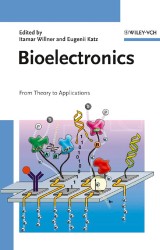Details

Bioelectronics
From Theory to Applications1. Aufl.
|
295,99 € |
|
| Verlag: | Wiley-VCH |
| Format: | |
| Veröffentl.: | 06.03.2006 |
| ISBN/EAN: | 9783527604180 |
| Sprache: | englisch |
| Anzahl Seiten: | 492 |
DRM-geschütztes eBook, Sie benötigen z.B. Adobe Digital Editions und eine Adobe ID zum Lesen.
Beschreibungen
Medicine, chemistry, physics and engineering stand poised to benefit within the next few years from the ingenuity of complex biological structures invented and perfected by nature over millions of years.<br> This book provides both researchers and engineers as well as students of all the natural sciences a vivid insight into the world of bioelectronics and nature's own nanotechnological treasure chamber.
Introduction<br> Electron Transfer in DNA -<br> Theory and Experiments<br> Electron Transfer through Proteins<br> Alignment of Redox Enzymes on Surfaces<br> Application of Electrically Contacted Enzymes for Biosensors<br> Electronic DNA Sensors<br> Probing Biomaterials on Surfaces at the Single Molecule Level for Bioelectronics<br> Interfacing Biological Molecules with Group IV Semiconductors for Bioelectronic Sensing <br> Biomaterial-Nanoparticle Hybrid Systems for Sensing and Electronic Devices<br> DNA-Templated Electronics<br> Single Biomolecule Manipulation for Bioelectronics<br> Molecular Optobioelectronicc<br> The Neuron-Semiconductor Interface<br> S-Layer Proteins in Bioelectronic Applications<br> Computing with Nucleic Acids<br> Conclusions and Perspectives<br>
"This is an excellent scientific resource for those interested in bioelectronics. It has breadth, depth, and clarity that leaves the reader with true appreciation for a very exciting field."<br> ChemBioChem <br> <br> "... an excellent introduction to and overview of bioelectronics ... a good addition to both personal and institutional libraries."<br> Journal of the American Chemical Society<br> <br> "The book will be of interest to bioengineers and professionals working in the area of bioelectronics. The different contributions allow chemists, biologists, physicists, materials scientists and engineers to start forming a good knowledge base in order to better deal with this field and attract newcomers to these new themes."<br> ChemPhysChem<br>
Itamar Willner is Professor of Chemistry at the Institute of Chemistry, The Hebrew University of Jerusalem, Israel. He graduated from the Hebrew University (1978), and after postdoctoral research at Berkley, he joined the faculty in Jerusalem in 1982. Prof. Willner is well known for his research in the areas of molecular electronics and optoelectronics, nanotechnology, bioelectronics, biosensors, optobioelectronics, nanobiotechnology, supramolecular chemistry, nanoscale chemistry and monolayer and thin-film assemblies. Prof. Willner holds the Israel Prize in Chemistry (2002), the Israel Chemical Society Award (2001) and the Max-Planck Research Award for International Cooperation (1998). He is a member of the Israel Academy of Sciences and Humanities and a member of the European Academy of Sciences.<br> <br> Eugenii Katz is a Senior Research Associate at the Institute of Chemistry, The Hebrew University of Jerusalem, Israel. He completed his Ph.D. in 1983 at the Frumkin Institute of Electrochemistry, Moscow, and until 1991 acted as senior scientist at the Institute of Photosynthesis, Pushchino, Russia. In 1991 he performed postdoctoral research at The Hebrew University of Jerusalem and later, as a recipient of the Humboldt scholarship, he worked at the Technical University of Munich (1993). He joined the research group of I. Willner at the Hebrew University in 1994. Dr. Katz holds the Kaye Awards for Scientific Innovations (1995 and 2004). His research interests include electroanalytical chemistry, functionalized monolayers, functionalized nanoparticles, biosensors, biofuel cells and bioelectronics.
Medicine, chemistry, physics and engineering stand poised to benefit within the next few years from the ingenuity of complex biological structures invented and perfected by nature over millions of years. The combination of biological elements -- be it whole cells, single molecules or anything in between -- with the field of inorganic electronics yields a fascinating spectrum of opportunities and potential applications. Neurons, DNA strands, antigens, antibodies or enzymes connected to conventional circuitry are capable of turning biological activity into defined electrical signals which can be interpreted and acted upon, opening up such applications as bio- and immunosensors, neuronal or DNA computing, bioassays, or biochemical batteries. Similarly, sophisticated human/machine interfaces and ecologically benign harvesting of energy are equally attractive paths awaiting exploration. This book provides both researchers and engineers as well as students of all the natural sciences a vivid insight into the world of bioelectronics and nature's own nanotechnological treasure chamber.<br>

















